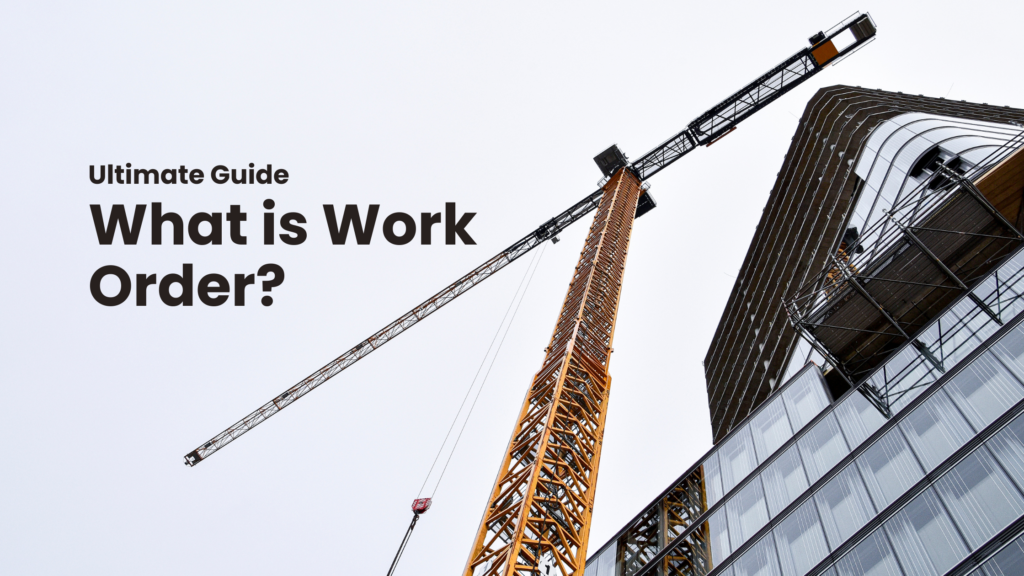Work Order
A work order is a formal instruction to perform specific tasks or services. It outlines the details of the work to be completed, including the scope, timeline, materials, labor, and costs associated with the project. Here’s a more detailed breakdown:
Key Elements of a Work Order:
- Description of Work: Define the project scope, outlining tasks, deliverables, and task specifications.
- Materials: List the materials necessary to complete the job.
- Resources: Identify the workers or subcontractors responsible for the work, along with the equipment and machinery needed to complete the tasks
- Timeline: Sets deadlines or timeframes for when the work must be completed.
- Approval and Signatures: Typically, the work order requires approval from a project manager or supervisor before work can begin.

Purpose of a Work Order:
- Clarity: Ensures that everyone involved in the project understands what is expected.
- Requirements: Outline the scope and requirements to ensure all work is performed accordingly.
- Financial Terms: Detail the payment amount and outline the payment procedure to ensure clarity and understanding for all parties involved.
- Accountability: Serves as a record to hold contractors and workers accountable for the completion of specific tasks.
Here are the types of Work orders used in Pakistan in accordance with Public Procurement Regulatory Authority (PPRA).
Must Read: Understanding the power of digital construction
Types of Work Orders
- Lump Sum Work Order
The contractor is paid a fixed amount for completing the entire project, regardless of the actual costs incurred. This type of work order is used when the scope of the project is well-defined, and there is little room for change.
Typically used in small to medium-sized projects where the scope and requirements are clear from the outset. For Example, Building a small residential house or a commercial structure with a fixed design.
- Unit Rate Work Order
Payment is based on a pre-agreed rate per unit of work completed (e.g., per square meter of flooring, per cubic meter of concrete). The total payment depends on the quantity of work executed.
Used in projects where quantities of work can vary, such as infrastructure projects or road construction. For example, Road construction projects where payment is based on the number of kilometres constructed.
- Time and Materials Work Order
In this type of work order, the contractor is paid for the actual time spent on the project and the materials used. This includes labour costs, material costs, and an additional fee for overheads and profits.
Commonly used in projects where the scope is not fully defined or may change, such as renovation or repair works. For Example, renovating an existing building or fixing structural damage where exact costs cannot be estimated upfront.
- Cost Plus Work Order
The contractor is reimbursed for the actual costs incurred during construction (such as labor, materials, and equipment) plus an additional fee for profit, either as a percentage or a fixed amount.
Used in large-scale projects with uncertain costs or projects where the owner wants to ensure quality without cutting corners. For example, large government or commercial building projects with fluctuating material and labor costs.
- Design and Build Work Order
The contractor is responsible for both the design and construction of the project. This type of work order integrates design and construction processes into one contract.
Used for projects where the owner wants a single point of responsibility and prefers to streamline the design and construction phases. For example, Construction of new infrastructure like bridges, buildings, or complex civil works projects.
- Turnkey Work Order
The contractor is responsible for the complete construction of a project, including design, construction, and final handover. The owner only needs to “turn the key” to begin using the facility.
Commonly used in industrial, commercial, and residential housing projects where the client wants a fully operational facility upon completion. For example, Housing societies, factory constructions, or office buildings where the contractor delivers the project ready for immediate use.
Process of Work order
In Pakistan’s construction industry, the process of issuing and executing work orders typically follows these steps:
- Project Planning and Initial Approval
- Scope Identification: The construction project is planned, and the scope of work is defined in collaboration with the client and stakeholders. This includes the type of work, materials required, and timelines.
- project proposal and budget are submitted to the relevant authorities (such as government departments or private clients) for approval.
- Request for Work Order
- Tendering Process: For public sector projects (especially under the Public Procurement Regulatory Authority (PPRA) rules), a tendering process is usually conducted. Contractors are invited to submit bids, and the contract is awarded based on criteria like cost, experience, and technical capabilities.
- Bidding Process: Bids are submitted against the engineer’s estimate to ensure transparency and fairness, with the bidder offering the lowest amount being selected.
- Contract Finalization: Final negotiations are conducted before the contract is finalized.
- Work Order Issuance
- Final Documentation: After the selection of the contractor, the relevant authorities issue a formal work order. The work order includes:
- Description of the project
- Specifications
- Duration or completion time
- Payment terms and conditions
- Milestones and deliverables
- Penalties for delays
- Contract Signing: Both parties (the contractor and the client) sign a contract that outlines the legal terms, including the scope, payment schedules, and completion deadlines.




Pingback: What is Construction Management - Ezypro